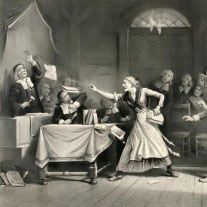 After researching the Salem witch Hunts, I’ve come to the conclusion that teenagers will be teenagers regardless of when they existed in History. Teenage girls circa 1690’s living in colonial Salem had a pretty drab life. All these girls did was chores and attend church. And “an idle mind is the devil’s work shop”…no pun intended. Can you imagine today’s teenagers doing just that? Boredom filled their days until they met a slave from the West Indies named Tituba. Tituba had thrilling and spellbinding stories she shared with these girls. The stories of faraway places and exotic people captivated the girls. As the days progressed, the more peculiar Tituba’s stories got. With a lot of drama, and flare, Tituba spoke of forbidden practices such as witchcraft, sorcery, voodoo, and other dark practices. This made an impression on these young girls.
After researching the Salem witch Hunts, I’ve come to the conclusion that teenagers will be teenagers regardless of when they existed in History. Teenage girls circa 1690’s living in colonial Salem had a pretty drab life. All these girls did was chores and attend church. And “an idle mind is the devil’s work shop”…no pun intended. Can you imagine today’s teenagers doing just that? Boredom filled their days until they met a slave from the West Indies named Tituba. Tituba had thrilling and spellbinding stories she shared with these girls. The stories of faraway places and exotic people captivated the girls. As the days progressed, the more peculiar Tituba’s stories got. With a lot of drama, and flare, Tituba spoke of forbidden practices such as witchcraft, sorcery, voodoo, and other dark practices. This made an impression on these young girls.
salemwitchSoon the girls exhibited odd behavior at home. They’d kicked and screamed, had fainting spells, spoke to apparitions, and complained of being bitten, and strangled by unseen hands. The more attention their families gave them, the more bizarre the outbursts. Just like a teenager… Soon the families and church became concerned and the only explanation they had for this was…it’s the devil’s work, and it must be stopped. After being questioned by their families and the church elders, the girls claimed that “witches” were the cause. The church leaders went on the hunt for the witches. They identified who they thought was a witch, most of which were elderly women. The poor women didn’t stand a chance…they all were tried (if you want to call it a trial) and hanged. In all, 20 women were hanged. These hunts and hangings went on for 2 years. The frenzy in these hunts was so bad that soon dogs were being accused of witchcraft. Two poor dogs were found guilty of witchcraft and were hanged.
How did this travesty happen? What motivated these young girls to do such a thing? The answer may lie in drugs. Some historians believe that the problem was Ergotism. Ergot is a fungus which grows in moldy grain and contains a mind-altering drug. Ergotism outbreaks, which affected entire regions, were common in Europe during the middle ages. But little was known of Ergot’s hallucinogenic effects in 17th century America. Today, ergot is used in drugs that help those with migraine headaches. If ergot is taken in its pure state, it becomes a powerful hallucinogenic. It is known to also cause disorientation, and even death.
The theory is that Tituba knew about the powerful drug in ergot, and introduced the young girls to the drug. Since Tituba knew a lot about sorcery, and voo-doo, it is speculated that she also knew of toxins, their sources, and effects. Historians believe that the girls were introduced to the grain and that they continued to consume it in greater quantities on their own. This can very well explain their bizarre behavior. Can we say that Tituba was also responsible for the 20 innocent women who were hanged? I believe that Tituba was playing with fire when she dabbled with the dark world and the drug world as well. I don’t think she ever expected what happened. But 20 innocent women paid the price nonetheless.
Books You Might Enjoy:
Anonymous - Healing Gemstones And Crystals
Jaroslav Nemec - Witchcraft And Medicine
Alice Bailey - Initiation Human And Solar
Kathryn Paulsen - Witches Potions And Spells








